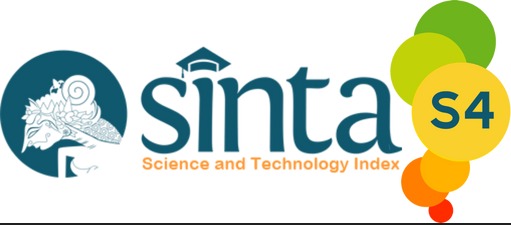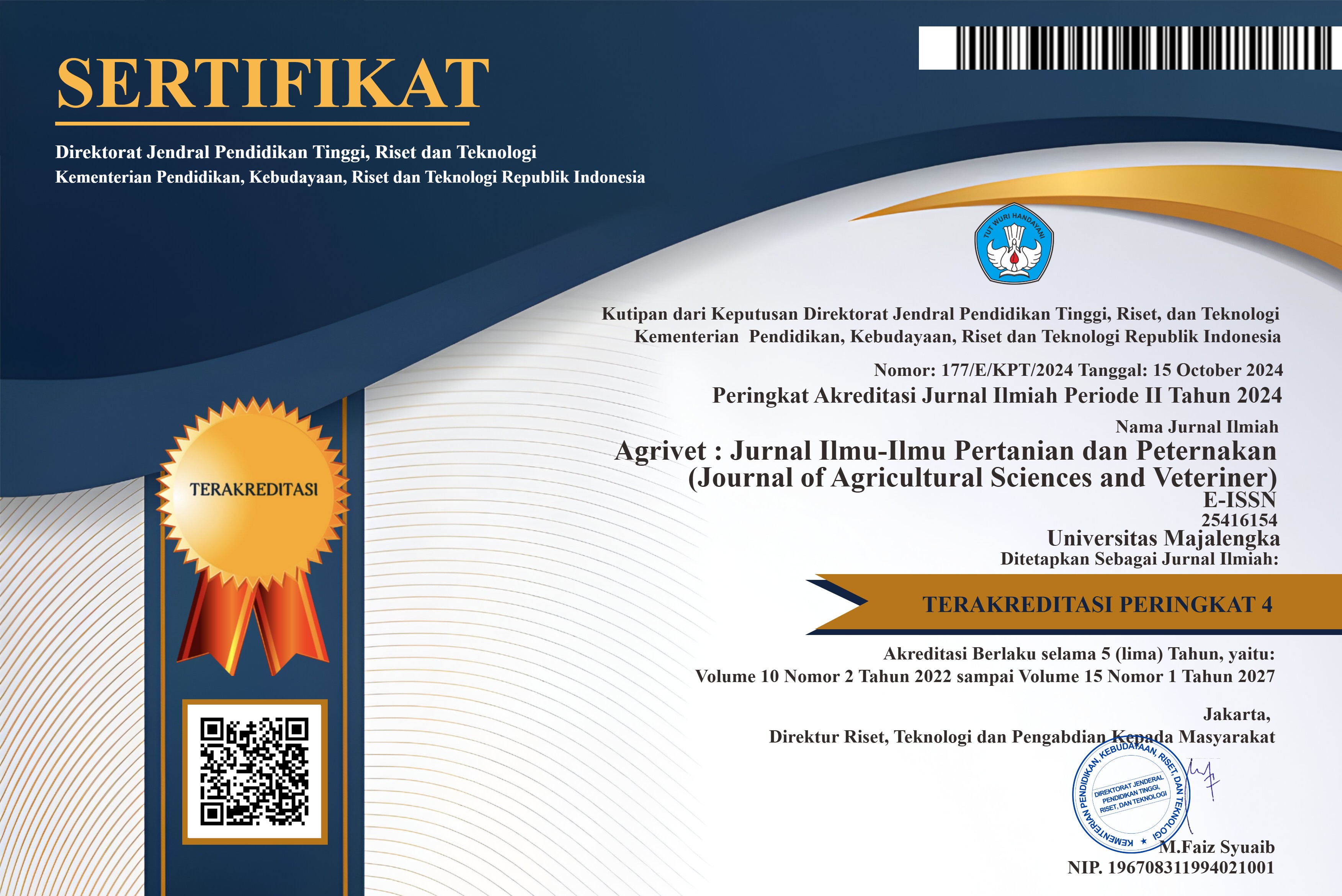EFEKTIVITAS HERBISIDA PARAQUAT DIKLORIDA 140 G/L TERHADAP PENEKANAN GULMA, PERTUMBUHAN, DAN HASIL JAGUNG (Zea mays L.)
DOI:
https://doi.org/10.31949/agrivet.v9i1.1147Abstract
Maize (Zea mays L.) is one of the cereal group's commodities with high economic value because of its position as the main source of carbohydrates and protein after rice. The problem that often occurs in maize cultivation and greatly affects maize productivity is weeds. Chemical weed control using herbicides in large crop areas can be the right choice because it can save production costs and reduce damage to soil structures. Paraquat dichloride herbicide is a non-selective contact herbicide, which has the characteristic that when exposed to sunlight the herbicide molecules react to produce hydrogen peroxide which damages cell membranes and all plant organs, causing the plant to burn. This herbicide can control grass and broadleaf weeds. The research conduct from March - July 2020 at the Ciparanje experimental field, Faculty of Agriculture, Padjadjaran University. The treatment design used a Randomized Block Design (RBD) with 7 treatments, namely: Paraquat dichloride 140 g/l at a dose 1.00 l/ha; Paraquat dichloride 140 g/l dose 1.25l/ha; Paraquat dichloride 140 g/l dose 1.50 l/ha; Paraquat dichloride 140 g/l dose 1.75 l/ha; Paraquat dichloride 140 g/l at a dose of 2.00 l/ha; Manual Weeding; Control (No Treatment). The difference in trials using the F test and tested using the Duncan test at the 5% real level. The results showed that applying the herbicide Paraquat dichloride 1.00 l/ha - 2.00 l/ha could control weeds in maize cultivation up to 6 weeks after application and positively affect the growth yield of maize.
Keywords:
herbicide efficacy, paraquat dichloride 140 g/L, weed, maizeDownloads
References
Bartolome, A. P., Villaseñor, I. M., & Yang, W. C. 201). Bidens pilosa L. (Asteraceae): Botanical properties, traditional uses, phytochemistry, and pharmacology. Evidence-Based Complementary and Alternative Medicine, Vol. 2013: 1 - 51.
Dwinata, Y. A., & Widaryanto, E. 2014. Kompetisi gulma kremah ( Alternanthera sessilis ) dengan tanaman terung ( Solanum melongena L .) Jurnal Produksi Tanaman, 2(1), 17–24.
Eullaffroy, P., & Vernet, G. 2003. The F684/F735 chlorophyll fluorescence ratio: A potential tool for rapid detection and determination of herbicide phytotoxicity in algae. Water Research, 37(9), 1983–1990. https://doi.org/10.1016/S0043-1354(02)00621-8
Hawkes, T. R. 2014. Mechanisms of resistance to paraquat in plants. Pest Management Science, 70(9): 1316–1323.
Kastanja A.Y. 2011. Identifikasi Jenis dan Dominansi Gulma pada Pertanaman Padi Gogo (Studi Kasus di Kecamatan Tobelo Barat, Kabupaten Halmahera Utara). Jurnal Agroforestri, 6(1): 40-49.
Kurniadie, D., Sumekar, Y., & Buana, I. 2017. Pengaruh berbagai jenis surfaktan pada herbisida glufosinat terhadap pengendalian gulma dan hasil tanaman jagung (Zea mays L.) di Jatinangor. Kultivasi, 16(2), 2015–2018.
Kurniastuty, C.B., D.R.J Sembodo, M.V. Rini, dan H. Pujisiswanto. 2017. Efikasi Herbisida Nabati 1,8-Cineole Terhadap Gulma Pada Perkebunan Kelapa Sawit (Elaeis guineensis Jacq.) Menghasilkan. Jurnal Agrotek Tropika, 5(1): 27 – 32.
Muoni, T., L. Rusinamhodzi., dan C, Thierfelder. 2013. Weed control in conservation agriculture systems of Zimbabwe: Identifying economical best strategies. Crop Protection, 53, 23–28
Murti, D. A., N. Sriyanti, S.D. Utomo. 2016. Efikasi Herbisida Parakuat Diklorida Terhadap Gulma Umum Pada Tanaman Ubi Kayu (Manihot esculenta crantz.). Fakultas Pertanian: Universitas Lampung. J.Agrotek Tropika 1(1): 07 – 10.
Padang, W.J., E. Purba, E.S. Bayu. 2017. Pengaruh Herbisida Atrazine + Nicosulfuron Terhadap Pengendalian Gulma dan Hasil Tanaman Jagung (Zea mays L.). Jurnal Ilmu Pertanian dan Peternakan, Vol. 5 (2) : 190-197.
Puspitasari, V. D. 2011. Studi Persaingan Gulma Terhadap Pertumbuhan dan Hasil Tanaman Jagung (Zea mays L.). Skripsi.Universitas Jember, Jember.
Rahni NM. 2012. Efek fitohormon PGPR terhadap pertumbuhan tanaman jagung (Zea mays). J Agribisnis Pengembangan Wilayah 3(2): 27-35.
Scher, J. 2004. Federal noxious weed disseminules of the US. Center for Plant Health Science and Technology. Online. diakses via http:/www.lucidcentral.org/keys/v3/fnw/
Tanveer, A. M. Ayub, A. A. R, Ahmad, 1999. Weed - crop competition in maize relation to row spacing and duration. Pakistan Journal of Biological Sci, 2(2): 363 – 364.
Wahyudin, A., Ruminta, R., & Nursaripah, S. A. 2017. Pertumbuhan dan hasil tanaman jagung (Zea mays L.) toleran herbisida akibat pemberian berbagai dosis herbisida kalium glifosat.
Published
How to Cite
Issue
Section
License
An author who publishes in the Jurnal Agrivet agrees to the following terms:
- Author retains the copyright and grants the journal the right of first publication of the work simultaneously licensed under the Creative Commons Attribution-ShareAlike 4.0 License that allows others to share the work with an acknowledgment of the work's authorship and initial publication in this journal
- The author is able to enter into separate, additional contractual arrangements for the non-exclusive distribution of the journal's published version of the work (e.g., post it to an institutional repository or publish it in a book) with the acknowledgment of its initial publication in this journal.
- The author is permitted and encouraged to post his/her work online (e.g., in institutional repositories or on their website) prior to and during the submission process, as it can lead to productive exchanges, as well as earlier and greater citation of the published work












